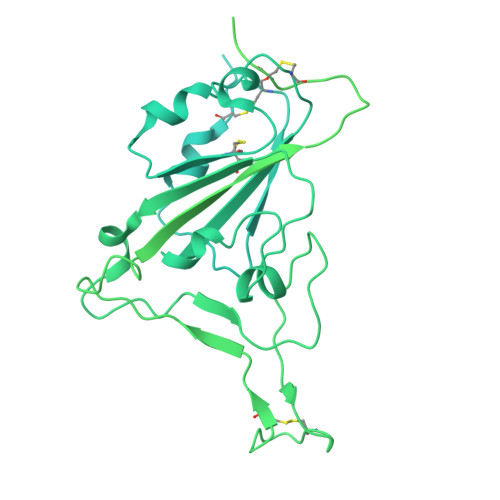Rapid restoration of potent neutralization activity against the latest Omicron variant JN.1 via AI rational design and antibody engineering.
Liao, Y., Ma, H., Wang, Z., Wang, S., He, Y., Chang, Y., Zong, H., Tang, H., Wang, L., Ke, Y., Cai, H., Li, P., Tang, J., Chen, H., Drelich, A., Peng, B.H., Hsu, J., Tat, V., Tseng, C.K., Song, J., Yuan, Y., Wu, M., Liu, J., Yue, Y., Zhang, X., Wang, Z., Yang, L., Li, J., Ni, X., Li, H., Xiang, Y., Bian, Y., Zhang, B., Yin, H., Dimitrov, D.S., Gilly, J., Han, L., Jiang, H., Xie, Y., Zhu, J.(2025) Proc Natl Acad Sci U S A 122: e2406659122-e2406659122
- PubMed: 39908098
- DOI: https://doi.org/10.1073/pnas.2406659122
- Primary Citation of Related Structures:
9JS4 - PubMed Abstract:
The rapid evolution of the viral genome has led to the continual generation of new variants of SARS-CoV-2. Developing antibody drugs with broad-spectrum and high efficiency is a long-term task. It is promising but challenging to develop therapeutic neutralizing antibodies (nAbs) through in vitro evolution based on antigen-antibody binding interactions. From an early B cell antibody repertoire, we isolated antibody 8G3 that retains its nonregressive neutralizing activity against Omicron BA.1 and various other strains in vitro. 8G3 protected ACE2 transgenic mice from BA.1 and WA1/2020 virus infection without adverse clinical manifestations and completely cleared viral load in the lungs. Similar to most IGHV3-53 antibodies, the binding sites of 8G3 and ACE2 largely overlap, enabling competition with ACE2 for binding to RBD. By comprehensively considering the binding free energy changes of the antigen-antibody complexes, the biological environment of their interactions, and the evolutionary direction of the antibodies, we were able to select 50 mutants. Among them, 11 were validated by experiments showing better neutralizing activities. Further, a combination of four mutations were identified in 8G3 that increased its neutralization potency against JN.1, the latest Omicron mutant, by approximately 1,500-fold, and one of the mutations led to an improvement in activity against multiple variants to a certain extent. Together, we established a procedure of rapid selection of neutralizing antibodies with potent SARS-CoV-2 neutralization activity. Our results provide a reference for engineering neutralizing antibodies against future SARS-CoV-2 variants and even other pandemic viruses.
- Engineering Research Center of Cell and Therapeutic Antibody, Ministry of Education, School of Pharmacy, Shanghai Jiao Tong University, Shanghai 200240, China.
Organizational Affiliation:


















